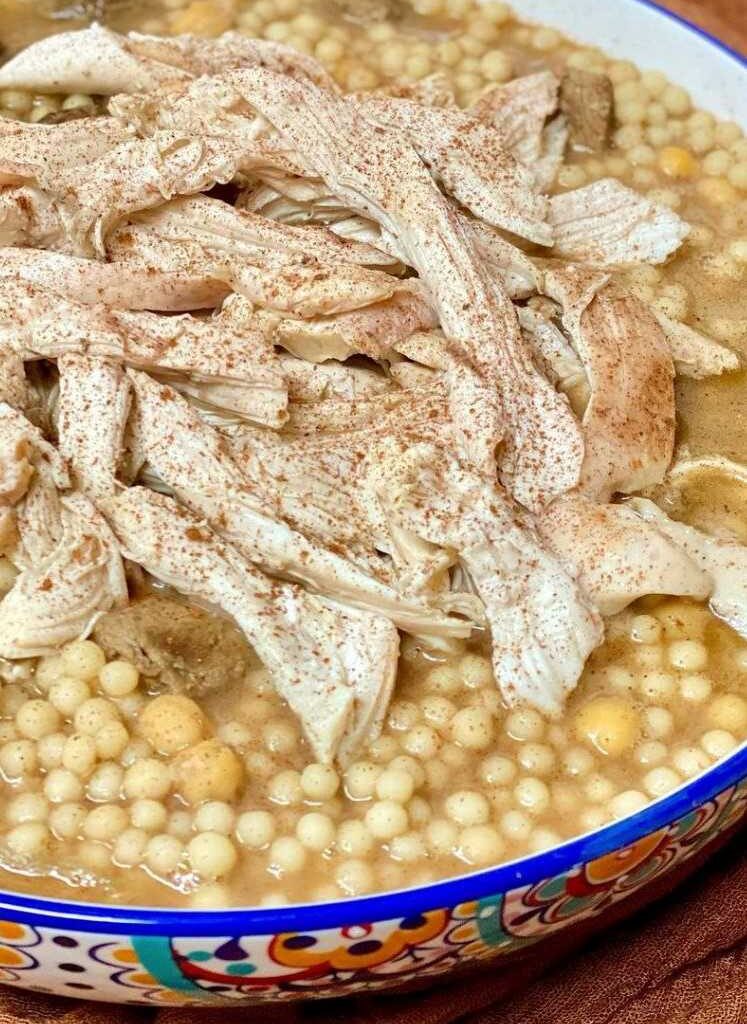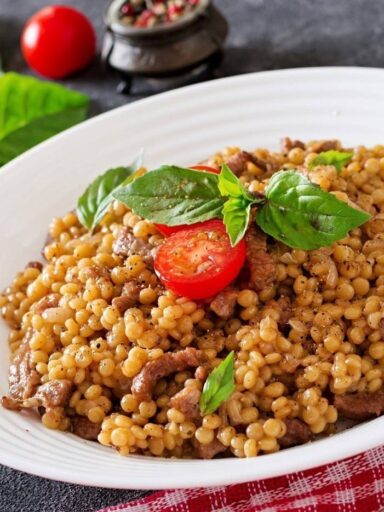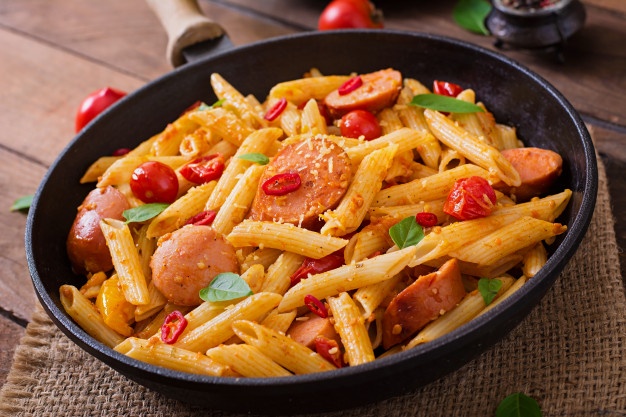Moghrabieh Recipe: A Middle Eastern Delight

Moghrabieh recipe (also known as pearl couscous or Lebanese couscous) is a traditional Middle Eastern dish that has been popular in the region for centuries. Its origins can be traced back to ancient times when it was a staple food for nomadic tribes who traveled through the deserts. Back then, Moghrabieh was made from wheat and water, which were kneaded together into small balls and then dried in the sun.
Over time, Moghrabieh evolved into its current form: a deliciously chewy pasta-like grain made from semolina flour. It is popular all over the Middle East, with different countries putting their own unique spin on it.
In Lebanon, for example, Moghrabieh is often served with chicken and chickpeas in a warm broth. Palestinians will often serve it with spiced lamb or beef and caramelized onions.
An Overview of the Moghrabieh Recipe
So how do you make Moghrabieh? The recipe can vary depending on the region, but it typically involves simmering the grain in a flavorful broth and serving it with meat and vegetables.
In our recipe, we’ll be using chicken thighs as the protein, along with carrots, celery, and chickpeas for added texture. To give the dish its signature Middle Eastern flavor, we’ll be using a blend of warm spices including cumin, coriander, cinnamon, and paprika.
These spices not only give the dish its irresistible aroma but also provide a multitude of health benefits due to their anti-inflammatory properties. Moghrabieh is a delicious and nutritious dish that is beloved throughout the Middle East.
Its rich history and cultural significance make it an inspiring addition to any home cook’s repertoire. So why not try this delightful recipe for yourself!
Ingredients
Moghrabieh (pearl couscous)
Moghrabieh is a type of Lebanese pasta that is similar to couscous but larger in size. It is typically made from semolina flour and water and can be found in Middle Eastern grocery stores or online.
Moghrabieh has a unique texture that is slightly chewy, which makes it perfect for absorbing the flavors of the dish it is paired with. When cooking moghrabieh, it’s important to soak it in warm water for at least 30 minutes prior to cooking to ensure that it cooks evenly.
Chicken thighs
For this recipe, boneless chicken thighs are used as they are more flavorful than chicken breasts and tend to remain tender even after long periods of cooking. Chicken thighs also have a higher fat content which adds richness and depth of flavor to the dish.
Onion, garlic, and ginger
Onion, garlic, and ginger are essential aromatics used in many Middle Eastern dishes including moghrabieh. They add depth of flavor and fragrance to the dish. When sautéed together with other spices like cumin, coriander, cinnamon, and paprika they create a base layer of flavors that serve as a foundation for the entire recipe.
Carrots and celery
Carrots and celery add sweetness and earthiness to the dish while also contributing a crunch factor. They are often used as aromatics in stews or soups due to their ability to absorb flavor while still maintaining their own texture.
Chickpeas
Chickpeas are an excellent source of protein for this recipe but also serve as a flavorful addition providing nuttiness with earthy undertones. They can be cooked from scratch or used canned for convenience.
Spices (cumin, coriander, cinnamon, paprika)
The spice blend used in this recipe is a classic combination that complements both the chicken and moghrabieh. Cumin adds nuttiness and warmth while coriander brings freshness.
Cinnamon adds a sweet and fragrant note while paprika brings a smoky depth of flavor. Adjusting the spices to your liking can make the dish more tailored to your preference.
Chicken broth
Chicken broth is added to the recipe as it provides a base level of flavor that helps bring everything together. It also tenderizes the chicken as it simmers, infusing its flavors into each bite of chicken and moghrabieh. Homemade stock is always recommended but store-bought works just fine as well.
Preparation:
Soaking the Moghrabieh:
Before you begin cooking moghrabieh, it is important to soak the pearl couscous. This will prevent it from taking too long to cook and ensure that it is a perfect texture by the time it is served.
Place the moghrabieh in a large bowl and cover with cold water. Allow the pearls to soak for at least 30 minutes or until they have expanded in size and softened.
Once the moghrabieh has finished soaking, drain any excess water using a fine mesh colander. Be sure to rinse them thoroughly with cold water before using them in your recipe.
Sautéing the Chicken and Vegetables:
To prepare this delicious dish, heat a large pot or Dutch oven over medium heat. Add oil to coat the bottom of the pot before adding chopped onion, garlic, and ginger. Sauté these aromatics for about 2-3 minutes until soft and fragrant.
Next, add chicken thighs that have been cut into bite-sized pieces along with chopped carrots and celery. Cook until chicken is lightly browned on both sides.
Adding Spices and Broth:
Once everything has been sautéed together, add your spices: cumin, coriander, cinnamon, paprika – these will give your dish its distinct Middle Eastern flavor profile. Stir everything together for about 30 seconds before adding chicken broth.
The broth will help create a flavorful base for your dish while also helping to tenderize the chicken as it cooks. Pour enough broth over everything so that all ingredients are covered completely.
Simmering Until Tender:
Bring everything up to a simmer. Cover your pot partially with a lid and reduce heat to low while allowing everything to cook slowly until tender.
Check on your dish periodically and give it a stir to make sure everything is cooking evenly. Your moghrabieh should take about 25-30 minutes to cook.
Once everything is cooked, remove pot from heat and allow it to cool slightly before serving. Enjoy your warm and comforting moghrabieh with family and friends!
Variations
Vegetarian Option with Roasted Vegetables Instead of Chicken
For those who prefer a vegetarian option, roasted vegetables can be used instead of chicken in this recipe. Simply chop up some hearty vegetables such as eggplant, zucchini, and bell peppers into bite-sized pieces and toss them in olive oil and salt.
Roast the vegetables in the oven at 400 degrees Fahrenheit for about 20-25 minutes or until tender. Once the vegetables are roasted, they can be added to the pot along with the moghrabieh, chickpeas, spices, and broth.
The rest of the recipe remains the same. This vegetarian option is just as delicious as the original recipe and provides a healthy dose of fiber and nutrients.
Addition of Raisins or Dried Apricots for Sweetness
To add a touch of sweetness to this savory dish, dried fruits such as raisins or chopped dried apricots can be added during cooking. This not only adds flavor but also provides a natural source of sugar that complements the spices well.
Simply add a handful of dried fruits to the pot along with everything else and let them cook together until tender. The sweetness will balance out any heat from the spices and make for a well-rounded dish.
Substitution of Lamb or Beef for Chicken
For those who prefer red meat over poultry, lamb or beef can be used instead of chicken in this recipe. Simply substitute an equal amount of lamb or beef for chicken thighs. Lamb is particularly popular in Middle Eastern cuisine due to its rich flavor that pairs well with fragrant spices like cumin and cinnamon.
Beef also works well in this recipe due to its hearty texture that holds up against all other ingredients. These variations offer many ways to customize this classic moghrabieh recipe to suit different dietary needs and flavor preferences.
Whether it’s a vegetarian option with roasted vegetables, addition of dried fruits for sweetness, or substitution of lamb or beef for chicken, the possibilities are endless. Try each variation and find your favorite!
Tips and Tricks
How to store leftover moghrabieh:
Moghrabieh is a hearty dish that is perfect for leftovers. Store it in an airtight container in the refrigerator for up to four days. When reheating, add a little bit of chicken broth or water to the pot to keep the moghrabieh moist.
You can also freeze leftover moghrabieh for up to three months. To freeze, allow it to cool completely before transferring it to a freezer-safe container.
How to reheat the dish without drying it out:
The key to reheating any leftover dish is ensuring that it doesn’t dry out. Moghrabieh can be reheated on the stovetop or in the microwave.
If using the stovetop method, add a small amount of chicken broth or water and cover the pot with a lid. Heat over medium-low heat until heated through, stirring occasionally.
If using a microwave, place the moghrabieh in a microwave-safe bowl and cover with plastic wrap or a damp paper towel. Microwave on high for 1-2 minutes at a time, stirring after each interval until heated through.
Serving suggestions:
Moghrabieh is typically served as a main dish, but can also be served as a side dish accompanied by grilled meat or fish. It pairs well with roasted vegetables such as eggplant, zucchini or bell peppers. For added texture and flavor, top with toasted nuts such as almonds or pine nuts before serving.
Alternatively, you can serve moghrabieh topped with fresh herbs such as parsley or cilantro for added freshness. To truly experience Moghrabie’s unique blend of flavors and textures we recommend serving it alongside traditional Lebanese mezze like tabouli, hummus, and baba ghanoush.
Conclusion
Recap of Recipe Steps
To recap the recipe steps, start by soaking the moghrabieh in hot water for about an hour. Meanwhile, sauté the chicken thighs and vegetables until brown.
Add the spices and broth to the pot, bring it to a boil, then reduce heat to low and simmer until tender. Add in the chickpeas and serve hot.
Importance and Versatility of Moghrabieh in Middle Eastern Cuisine
Moghrabieh has been a staple of Middle Eastern cuisine for centuries, with its origins tracing back to Lebanon. It is a versatile ingredient that can be used in many dishes such as stews, salads, or even as a substitute for rice or pasta.
Its unique texture sets it apart from other grains as it is fluffy yet chewy at the same time. Moghrabieh is also important culturally because it brings people together over meals.
In many Middle Eastern countries, hospitality is highly valued and breaking bread with guests is seen as an expression of welcoming them into your home. The act of sharing moghrabieh dishes symbolizes this tradition and creates a sense of unity among people.
Encouragement
Don’t be afraid to experiment with moghrabieh in your cooking! This ingredient can add depth and flavor to any dish you create. Whether you’re looking for a vegetarian option or want to spice up your meat dishes with something new, moghrabieh can be adapted into almost any recipe.
So next time you’re cooking for friends or family, consider incorporating this delightful grain into your meal plan. You’ll not only impress everyone with your culinary skills but also bring cultural significance to your dinner table by sharing an experience rooted in history and tradition.
See more
- Couscous with fried chicken
- Couscous Perlato
- Bulgur Chickpea Salad
- Rainbow Moghrabieh (Pearl Couscous) Salad

Moghrabieh Recipe: A Middle Eastern Delight
Ingredients
Instructions
Heat the olive oil in a large pot over medium heat. Add the onions and garlic and sauté for 2-3 minutes until the onions are translucent.
Add the lamb or chicken to the pot and cook until browned on all sides.
Add the cumin, paprika, and coriander to the pot and stir until the meat is coated in the spices.
Pour in the chicken broth and bring to a boil. Reduce the heat and let simmer for 30 minutes.
Add the moghrabieh pasta and chickpeas to the pot and stir. Cover the pot and let simmer for an additional 20 minutes, or until the pasta is tender.
Once the pasta is tender, remove the pot from the heat and let sit for 5 minutes. Season with salt and pepper to taste.
Serve hot, garnished with fresh parsley if desired.









